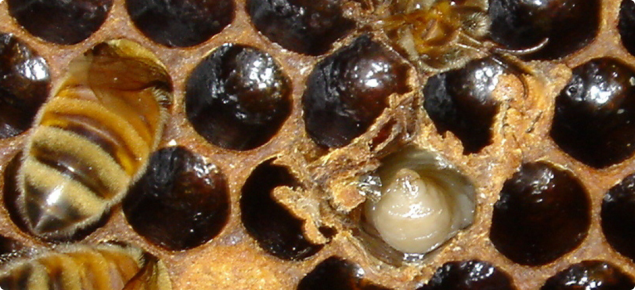Sacbrood disease
Some research workers thought that sacbrood virus, in combination with bacteria, caused European foulbrood disease. However, in 1912 it was shown that sacbrood virus was not associated with European foulbrood disease.
Because of similarities in appearance between sacbrood disease, European foulbrood disease and American foulbrood disease, it is necessary for beekeepers to recognise the different signs of these diseases.
Causes
Sacbrood disease is caused by a virus. The virus is common in hives but only causes disease in bees that are genetically susceptible. The appearance of the disease in early spring may be due to poor detection and removal of diseased larvae by nurse bees. This is caused by an increased larva to adult ratio; however, as the colony expands and develops sufficient strength, the nurse bees are able to cope with the disease.
Sacbrood disease can become apparent after bees are stressed by beekeeping management practices such as re-queening or moving hives.
Signs
Larvae affected by the virus die after the cell has been capped. Nurse bees pierce the capping to expose the dead larvae and the raised mouth parts of the larvae are a sign of sacbrood. The affected larvae change colour starting at the mouth parts from white through to yellow and dark brown. Some affected larvae develop a sac of liquid at the anal end.
The brown larvae may dry to form wrinkled, brittle scales which are easily removed from the cell. Drone brood may also be affected with sacbrood disease.
Cells still capped after the surrounding brood has emerged may indicate that the disease is present. Sacbrood is most commonly seen in the early spring and the signs of the disease disappear with warmer weather and a good honey flow.
The first appearance of sacbrood should not be confused with American foulbrood disease. The distinguishing characteristics are that the brown larvae will not ‘rope’ as with American foulbrood disease and the beekeeper should test for ‘rope’ effect. Scales caused by sacbrood are easily removed while those caused by American foulbrood disease adhere to the cell wall and cannot be removed in one piece. Where American foulbrood and sacbrood diseases occur in a hive at the same time, the visual signs and ‘rope’ effect of American foulbrood disease may become less obvious.
It is essential any sign of disease is reported and a piece of comb, together with slide smears is sent for laboratory confirmation. Correct diagnosis will enable the beekeeper to manage the disease and prevent further spread within the apiary.
Spread
The spread of viruses is not well known; however, it is thought that any cross contamination by the beekeeper could spread the disease. Bees ‘drifting’ from hive to hive, contaminated drinking water, contaminated equipment and wind may also transmit the virus.
Honey bees act as a reservoir for the sacbrood virus. Viruses appear to accumulate in the hypopharangeal gland of worker bees, and these bees may transmit the infection to larvae through feeding.
Scientists have yet to determine how the sacbrood virus is transmitted, how the virus persists and why severe outbreaks occur only during the build up season.
Diagnosis
Diagnosis of sacbrood disease is difficult because special reagents are required to identify the virus. However, material collected from affected apiaries can be examined for the presence of a virus in the electron microscope at the Animal Health Laboratories, South Perth. The presence of virus in colonies showing visual signs of the disease is sufficient for diagnosis of sacbrood.
Control
Because sacbrood disease is caused by a virus, there is no method of treating affected bees. Re-queening hives showing persistent or severe signs of the disease is recommended. New queens should come from hives that show resistance to the disease.
Hygiene is important in limiting or preventing the spread of disease. Beekeepers are advised to maintain good apiary hygiene as outlined below:
- Avoid the introduction of bees and equipment from unknown sources.
- Avoid exposing honey combs or equipment to robbing. Spare equipment may be stored and fumigated away from robber bees.
- Watch for signs of the disease.
- Report any brood abnormalities immediately, by telephoning PADIS, free call 1800 084 881. Brood diseases are notifiable and beekeepers are legally required to report them.
- Submit slide smears and a sample of comb to the Animal Health Laboratories, Department of Agriculture and Food, Western Australia, South Perth.
Procedures for submitting samples
- Obtain microscope slides from Animal Health Laboratories, South Perth.
- Identify the hive from which the samples are taken.
- Select a piece of affected comb not less than 75mm square.
- Write your name and hive identification number on a clean microscope slide using a permanent marking pen.
- Select two larvae showing early signs of the suspected disease. Place one at each end of the slide.
- Mash the larvae thoroughly using a clean match for each larva.
- Remove the bulk of the larval remains from each mashed larva, leaving a separate patch of milky liquid (about the size of a 5 cent piece) at each end of the slide.
- Allow to dry but protect from the sun at all times.
- Submit five slides for diagnosis, each containing two larvae.
- Pack slides to protect from breakage and the comb to prevent leakage and post with the completed form to:
Animal Health Laboratories
Department of Agriculture and Food, Western Australia
Locked Bag 4
Bentley Delivery Centre WA 6983
or
3 Baron-Hay Court
South Perth 6151
- Please note, some costs may be incurred.

